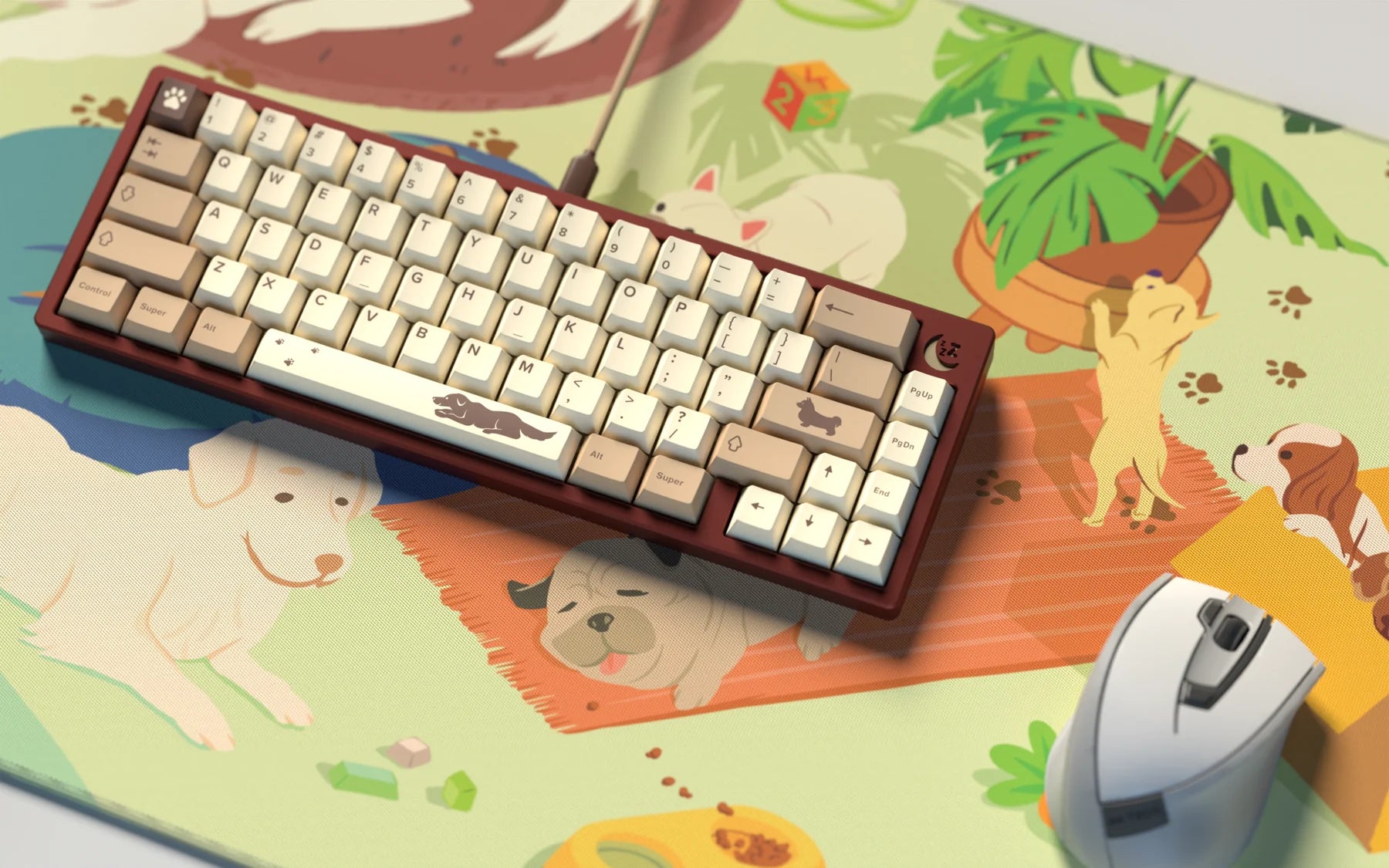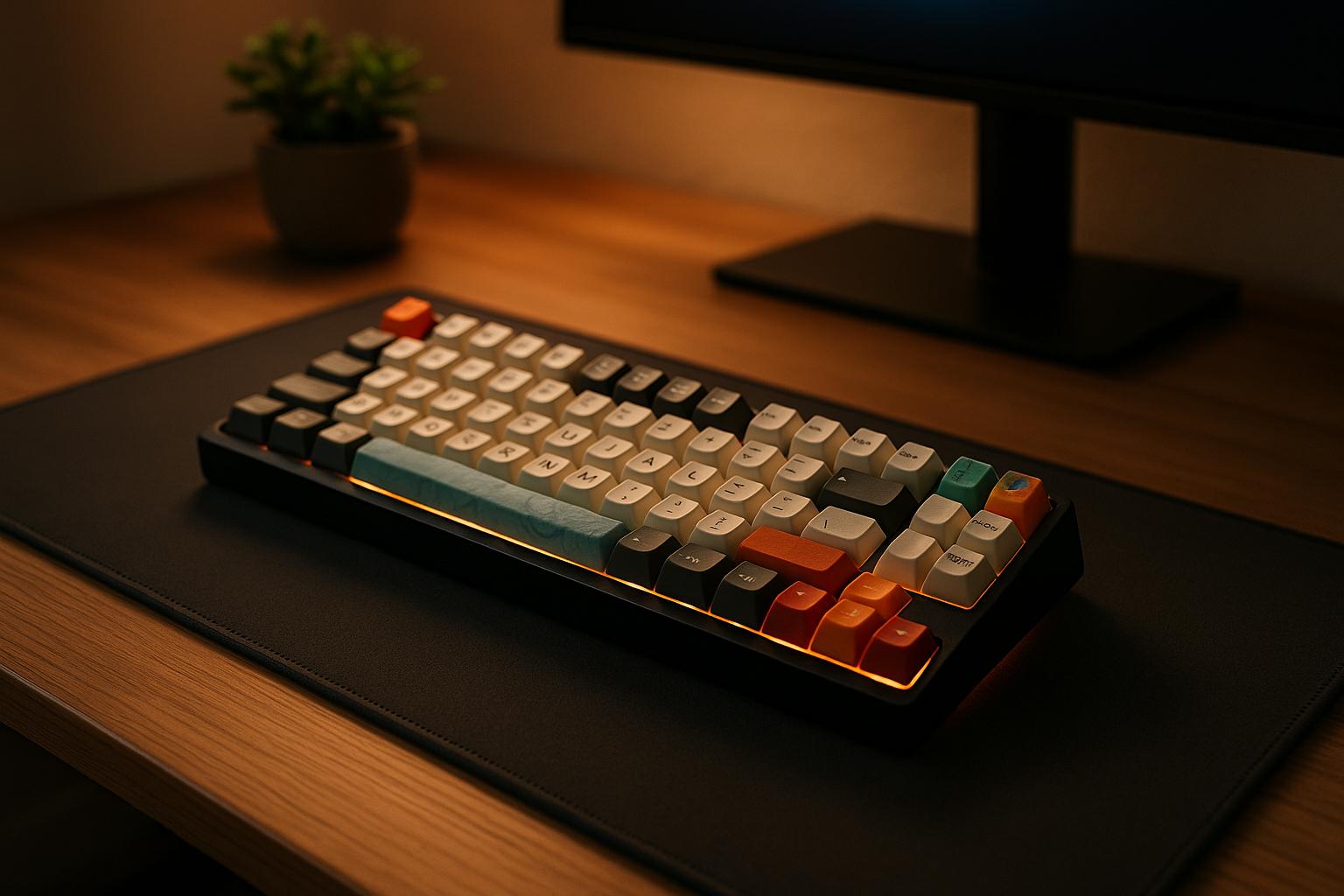Key chatter, or when a single key press registers multiple times, can make typing frustrating. Here's how to fix it:
- Clean your keyboard: Dust and debris are common causes. Use compressed air, isopropyl alcohol, and a microfiber cloth to clean keycaps and switches.
- Update firmware and adjust debounce settings: Firmware bugs or incorrect debounce settings can lead to chatter. Update your keyboard's software and tweak debounce settings to filter out extra keystrokes.
- Replace faulty switches: If cleaning and software adjustments don't work, replace the problematic switches, especially on hot-swappable keyboards.
Prevention tips: Regularly clean your keyboard, avoid eating near it, and store it in a clean, dry environment. With proper maintenance, you can keep your keyboard chatter-free and extend its lifespan.
How To Fix Mech Keyboard Double Typing/Chattering!
How to Identify Key Chatter Issues
Catching key chatter early can save you a lot of headaches. By recognizing the warning signs and using testing tools, you can confirm the problem and plan your next steps.
Signs Your Keys Are Chattering
The clearest sign of key chatter is when a single key press results in multiple characters appearing on your screen. For example, typing "Hello" might turn into "Heello" or "Helllo." This happens because the key's switch registers multiple strokes from one press due to rapid, unintended contact bouncing.
Other signs to watch for include:
- Inconsistent key behavior: Some keys may need to be pressed multiple times to register, while others might overreact and register repeatedly. This often forces you to overuse the backspace key to clean up unwanted characters.
- Issues during gaming: In games, a single press of a movement key could be misinterpreted as multiple presses, leading to erratic or unintended character movements.
- Typing disruptions: You might notice your natural typing flow being interrupted as you pause to fix errors caused by chattering keys.
Testing Your Keyboard with Software
Online keyboard testers are a quick and easy way to check for key chatter without downloading anything. These tools let you press each key and immediately see if any are registering multiple presses.
For more in-depth testing, software like Switch Hitter can be a game-changer. It visually displays key states (unpressed, depressed, pressed, alert) and logs every key press in detail. This includes a chatter indicator that flags problematic keys. Additionally, its customizable layouts allow you to test your specific keyboard setup. While simpler tools like QMK Toolbox can be helpful, they lack advanced features like detailed logging and chatter detection.
When testing, press suspect keys multiple times at different speeds to spot inconsistencies. Once you've gathered data, look for patterns to identify which switches are causing problems.
Finding Patterns in the Problem
After testing, take note of which keys consistently show issues. Key chatter rarely affects all keys equally. Often, the most frequently used keys or those in the center of the keyboard are more prone to problems because of wear and tear or dust buildup. Mechanical switches are typically rated for 50 to 100 million clicks, so heavily used keys may wear out faster.
The location of affected keys can also provide clues. Central keys might experience more issues due to frequent use and exposure to dust, while edge keys might suffer from uneven pressure. Environmental factors like humidity and temperature can also play a role. For instance, some users notice increased chatter during hot or humid weather, which can affect the switches. Similarly, issues might arise after cleaning your keyboard or moving it to a new environment.
To better understand the problem, keep a log of misbehaving keys, the conditions under which the issues occur, and any environmental changes. For example, slight differences in how you press a suspect key could trigger additional activations.
Identifying these patterns can help you decide on a fix. If the problem is isolated to a few keys, replacing the switches might be enough. However, if the issue is widespread, you may need to explore firmware updates or address environmental factors.
How to Fix Key Chatter: Step-by-Step Solutions
Once you've pinpointed which keys are acting up, it’s time to tackle the problem. Start with cleaning and tweaking settings; if that doesn’t work, move on to firmware updates and debounce adjustments. If all else fails, replacing the switches might be your final step.
Clean Your Keyboard and Switches
Dust, debris, and dried lubricant are often the main reasons behind key chatter. To start, carefully remove the keycaps using a puller to avoid damage. Use compressed air to blow away loose dust from the keyboard surface and switches. Then, gently wipe the keyboard with a damp microfiber cloth.
For keyboards with stubborn grease or oil buildup, mix a cleaning solution by diluting isopropyl alcohol with water to about 30% alcohol, or use a small amount of mild detergent mixed with water. This helps break down grime without harming the components.
If the issue persists, focus on the switches themselves. Use compressed air and a soft brush to clean between the switch components. For deeper cleaning, dampen a cotton swab or cloth with 70% (or higher) isopropyl alcohol and clean around the switches, being careful not to use too much liquid.
For sticky keys, you may need to take apart the switch. Clean the casing with compressed air or a brush, and wipe the contact points with an alcohol-dipped cotton swab. Let all parts air dry completely before reassembling. To keep your keyboard in good shape, consider doing this every 3–6 months.
If cleaning doesn’t fix the problem, move on to updating your keyboard’s firmware and adjusting debounce settings.
Update Firmware and Adjust Debounce Settings
Updating your keyboard’s firmware can fix bugs that might be causing key chatter while also improving overall performance. Debounce settings, on the other hand, manage how the keyboard handles rapid key presses, reducing the chances of multiple clicks being registered as one.
Before making changes, back up any custom settings. Then, update the firmware via USB following the manufacturer’s instructions, and test the keyboard to ensure everything works as expected. For Keychron keyboards, you can use the Keychron launcher in "Advanced Mode" to fine-tune debounce settings, and then test the keys again.
If firmware updates and debounce adjustments don’t resolve the issue, it might be time to replace the problematic switches.
Replace Broken Switches
If key chatter continues or you notice reduced tactile feedback, actuation problems, changes in sound, or visible damage, it’s likely time to replace the switches. Before committing to replacement, try one last cleaning using compressed air or a switch cleaning tool.
For hot-swappable keyboards, the process is straightforward: remove the faulty switch and insert a new one, ensuring the pins are properly aligned. After installing the new switch, double-check for bent pins and adjust them if necessary.
For soldered keyboards, replacing a switch is more complex. You’ll need to desolder the old switch and solder in a new one, which requires specific tools and some technical know-how. If you’re not confident in your soldering skills, it’s a good idea to seek help from a professional.
When replacing switches, opt for high-quality components from trusted suppliers like KeebsForAll to ensure durability and smooth performance. Remember, mechanical switches wear out over time, especially with frequent use. Regular maintenance and occasional replacements are essential to keep your keyboard functioning at its best.
sbb-itb-3cb9615
How to Prevent Key Chatter in the Future
Stopping key chatter before it starts is the best way to keep your keyboard running smoothly. Once you've dealt with any current issues, adopting good maintenance habits can help you avoid trouble down the road. Here's how you can keep your keyboard in top shape.
Clean and Maintain Your Keyboard Regularly
Keeping your keyboard clean is one of the easiest ways to prevent key chatter. Dust, crumbs, and moisture can all interfere with your keyboard's switches, so a consistent cleaning routine is essential.
Here’s a simple cleaning schedule to follow:
- Daily: Flip your keyboard upside down and give it a gentle shake to knock out loose debris. Use compressed air to clean between the keys and wipe the surface with a microfiber cloth lightly dampened with isopropyl alcohol.
- Weekly: Use a vacuum with a soft brush attachment to remove deeper dirt and prevent buildup that could affect switch performance.
- Monthly: Disconnect your keyboard and remove the keycaps using a keycap puller. Clean the exposed areas with cotton swabs dipped in rubbing alcohol. Soak the keycaps in warm, soapy water, then scrub and dry them thoroughly before reattaching.
For mechanical keyboards, consider lubricating the switches every 6–12 months with a lubricant designed specifically for keyboards. This reduces friction and wear over time. Another simple tip? Wash your hands before using your keyboard to limit the transfer of oils and grime.
Protect Your Keyboard from Damage
Beyond cleaning, protecting your keyboard from environmental damage is just as important. Store it in a clean, dry location, away from direct sunlight and extreme temperatures. Use a dust cover when the keyboard isn’t in use to prevent debris from settling on it.
Temperature swings and humidity can impact switch performance, and condensation can lead to key chatter. Keep your workspace tidy and avoid eating or drinking near your keyboard to prevent accidental spills or sticky residues that could harm the internal components.
Conclusion: Keep Your Keyboard Chatter-Free
Key chatter doesn’t have to be a permanent problem. Both hardware and software solutions are available to tackle this issue effectively.
Start by giving your keyboard a thorough cleaning. Use compressed air and isopropyl alcohol to remove dust and debris from the switches and keycaps. If cleaning doesn’t resolve the problem, try software adjustments, which can offer a quick and practical fix. For persistent chatter, replacing faulty switches - especially on hot-swappable keyboards - can provide a long-term solution.
The best strategy, though, is prevention. Regular maintenance, like cleaning your keyboard, updating firmware, and addressing small issues early, can extend your keyboard’s lifespan and keep it performing at its best.
If you’re looking for tools and supplies to maintain or upgrade your keyboard, KeebsForAll has you covered. From keycap pullers and switch openers to premium Krytox 205 g0 lubricant for smoother switch action, they offer everything you need. Whether you’re replacing faulty switches or upgrading to a hot-swappable keyboard for easier future maintenance, investing in high-quality components will help keep your keyboard chatter-free.
Stay ahead of potential issues by keeping your workspace tidy, using a dust cover when your keyboard isn’t in use, and performing regular upkeep. With consistent care and the right tools, your mechanical keyboard can provide a precise and dependable typing experience for years to come.
FAQs
How can I tell if my mechanical keyboard is experiencing key chatter?
Key issues with a mechanical keyboard can pop up in a few distinct ways:
- Double or Repeated Typing: You press a key once, but it registers multiple times. For example, hitting 'a' might result in 'aa' or even 'aaa' on your screen.
- Inconsistent Keystrokes: Certain keys might not respond consistently, either failing to register or working only sporadically.
- Unpredictable Behavior: Dust, dirt, or malfunctioning switches can send unintended signals, causing keys to act erratically.
If these problems sound familiar, it’s probably time to take action. Start by giving your keyboard a thorough cleaning, check for firmware updates, or consider swapping out faulty switches. Need reliable parts and tools? KeebsForAll has you covered with a wide selection of mechanical keyboard components and accessories.
How do I adjust debounce settings to fix key chatter on my mechanical keyboard?
To cut down on key chatter with your mechanical keyboard, one effective solution is tweaking the debounce time in the firmware settings. Many customizable keyboards - especially those running on QMK or ZMK firmware - let you modify this value. Debounce time essentially controls how long the keyboard waits to confirm a stable keypress after detecting contact in the switch. While 5 milliseconds is a common default, slightly increasing this value can help reduce chatter. Check your keyboard's firmware documentation for step-by-step guidance on making this adjustment.
Beyond firmware tweaks, maintaining clean keyboard switches is essential. Dust and debris can exacerbate chatter, so regular upkeep - like cleaning the switches and checking for proper connections in hot-swappable sockets - can significantly improve performance. If cleaning doesn’t solve the problem, replacing faulty switches might be necessary to eliminate the issue entirely.
How can I prevent key chatter on my mechanical keyboard, and how often should I maintain it?
Keeping your mechanical keyboard in top shape can help avoid key chatter and ensure a smooth typing experience. Regular maintenance makes all the difference. Start by giving your keyboard a quick clean every few weeks to clear out dust and debris that might mess with the switches. A can of compressed air works wonders for this, and for a more detailed clean, you can use a small amount of isopropyl alcohol to gently wipe the switches.
If you want to go the extra mile, lubricate the switches every 6 to 12 months. This reduces friction and helps prevent chatter. For a deeper clean, aim to disassemble and thoroughly clean your keyboard every 3 to 6 months. Between these deep cleans, a simple weekly wipe down with a microfiber cloth will keep it looking and working great. These easy steps can significantly extend your keyboard’s life and keep your typing as smooth as ever.



![[Pre-Order] Autumn Leaves PBT Keycaps - KeebsForAll](http://keebsforall.com/cdn/shop/products/DSC09732.jpg?v=1676148273)






Leave a comment
This site is protected by hCaptcha and the hCaptcha Privacy Policy and Terms of Service apply.